
Furnace also? Lights?
Furnace also? Lights?
Zhou Yunxiang
Among the numerous celadon products collected by Zhengzhou Shanhaiguo Museum, two objects with unique shapes and beautiful glaze color are particularly eye-catching. Their seemingly ordinary appearance contains rich historical information, such as what is its name and what is it used for? When is its age? Through our meticulous exploration, the audience may finally realize that it is so closely related to people's lives and eventually fall in love with her.
These two objects are called stoves. Perhaps the audience will wonder, how can such a small object be a furnace? Do you use it to make a fire and cook? Of course, it is impossible to cook with a fire, but it is related to the use of fire. It may be a hand stove used by the ancients to warm their hands. We have archaeological evidence and look at their beautiful figures.
Both utensils are damaged. The tire at the stubble-breaking place is gray, near the straight mouth, with the mouth protruding upwards, the wide fold inclines downwards along the outside, with a thin round lip and the abdominal wall flaring out. When the wheel is made, the outer wall is deliberately made into equidistant wide grooves, which is very melodious, as if there is endless meandering water flowing, the inner bottom is the bottom, the lower handle is short, and the lower horn is full. There is no glaze on the inner bottoms of the two vessels, and blue glaze is applied to the mouth from the inner wall to the outer wall, one is green glaze, and the other is green and brown glaze. The glaze layer is thin, the glass has strong light sensitivity, there are fine ice cracks, and the convex edge, the upper lip of the wide edge and the convex edge of the circle foot have iron mouth characteristics. The former is 10 cm in diameter, 6.2 cm in foot diameter and 8.7 cm in height, while the latter is 10.6 cm in diameter, 4.8 cm in foot diameter and 7.5 cm in height. (Figures 1 and 2)
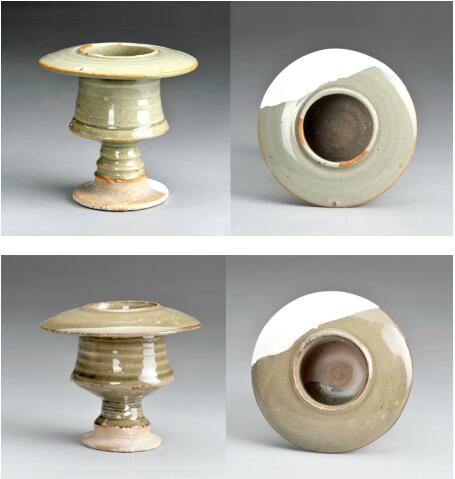
Judging from the shape, the two utensils are placed on the ground too small, so they are easy to be kicked over, and they can't be placed in the sleeve by hand. Judging from their trumpet-shaped circle feet, they can be placed on the table. The shape of the utensils is neither too big nor too small, which is why we call it a hand stove. Its inner wall is unglazed, and it is just used to hold charcoal fire, and when people's hands are cold, they can be put together to keep warm. Of course, there is no direct scene of ancient people warming their hands to confirm our conjecture. We observe it from a mural of a Liao Dynasty tomb in which a maid holds a stove and think it is possible.
In 1993, Hebei Provincial Institute of Cultural Relics, Zhangjiakou Cultural Relics Management Office and Xuanhua District Cultural Relics Management Office jointly excavated Zhang Shiben, Zhang Wenzao, Zhang Kuangzheng and the unknown Tomb No.6 of the Southeast Group of Xuanhua mural tomb cemetery in Zhangjiakou (all the mural tombs in Xuanhua are from the book Xuanhua Liao Tomb [1]). The burial dates of Zhang Shiben, Zhang Wenzao and Zhang Kuangzheng are all AD 1090. M6 is a double-chamber tomb with a sloping staircase entrance. The front room is rectangular, with scattered music pictures and tea preparation pictures, and the back room is octagonal, which is equivalent to an inner bedroom. A maid who carries a lamp is painted next to the crane grass in the southwest wall, and a maid who draws a left-hand stove next to the crane grass in the southeast wall. These two people are responsible for taking care of the life of the tomb owner. (Figure 3) From the color point of view, the furnace is a white porcelain furnace, which is wide and flat, inclines downward along the outside, and the lower part of the abdominal wall is flared, folded into a bottom and short. Judging from the ratio of the furnace to the hand, the diameter of the furnace is more than 25 cm and the height is about 16 cm, which is about twice as large as the celadon furnace in our library.
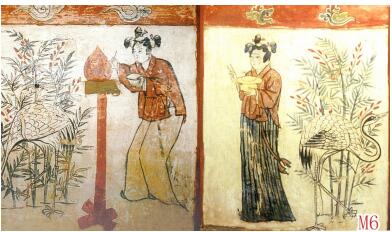
This kind of furnace appears on murals, which is the only example. There are many mural tombs in the Yellow River valley, but this kind of round foot furnace with wide edge and folded abdomen is not seen on the murals. Let's discuss this. Is it a furnace? What's the stove for?
In the archaeological investigation and excavation briefing of the older generation of archaeologists, this kind of furnace is generally called a lamp. Now it seems that it is certainly not a lamp. There are three reasons: from the shape, the inner wall has no glaze, which is not conducive to protecting the lamp oil; If it is a lamp, the wick is nowhere to be placed, and it seems to be everywhere; According to the current archaeological data, the lamp used in the Song and Jin Dynasties was a bowl with a shallow belly. A bowl lamp and a three-color stove were unearthed at the same time in M3[2], a mural tomb of the Song Dynasty in Tangzhuang, Dengfeng. The age of this tomb is about 1060-1090 AD according to the brick carving of the tomb wall. (Figure 4)
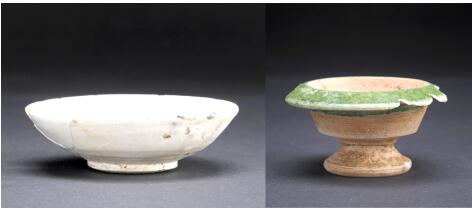
Since it is not a lamp, what kind of furnace is it? The Henan Provincial Institute of Cultural Relics and Archaeology called this kind of stove in its large-scale excavation sites, such as the Miaodigou Tang and Song Tombs in Sanmenxia [3] and the Yexian Anthology Site [4], but did not say what it was used for. Mr. Qin Dashu of Peking University Wenbo College has always called this kind of stove a incense burner in his excavation sites. As we know, the shape of the incense burner in the Yuan Dynasty is certain, generally there are vertical ears on both sides of the folding edge and three feet under it, such as the Jun porcelain incense burner unearthed from Zhang Honglve's tomb in Mancheng, Hebei Province in 1295. (Figure 5, left) The shape of the incense burner in the Jin Dynasty is similar to that in the Yuan Dynasty, but it generally has no ears and its neck is not so high, such as the Jun porcelain incense burner unearthed from Yan Deyuan's tomb in Datong in 1190. (Figure 5, right)

The incense burner in Song Dynasty has not been seen in the tombs at present. Judging from the maturity of the incense burner in Jin Dynasty, it should have existed in Song Dynasty. Therefore, some kiln site survey catalogues directly call the collected incense burner in Song Dynasty, either according to their own opinions or according to the stratum. As we know, kiln sites are different from tombs, and the strata are easy to disturb future generations. If an object is not engraved, its age cannot be easily determined. If there is evidence from the dating tombs, it can be roughly dated. The so-called incense burner in the Song Dynasty was in this situation. Even so, from the point of view that the incense burner has three legs, the incense burner in the Jin Dynasty may come from the three-color incense burner in the late Tang Dynasty, such as the three-color incense burner seen in the tomb of Su Xu and his wife in 901 AD in Nanle, Henan Province, so the incense burner in the Song Dynasty may also have three legs. (Figure 6) In this way, the shape of the incense burner in the Song Dynasty is very different from that of the white porcelain burner held by Xuanhua M6 maid, so it is not accurate to call this kind of burner with a wide edge and a folded belly with a circle foot as a incense burner.
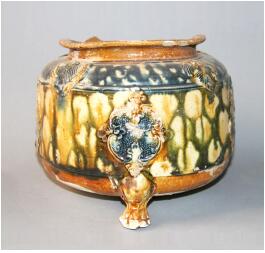
The tomb owner of M5 in Xuanhua mural tomb is Zhang Shigu, who was buried in 1117 AD. The tomb is also a front and back room, with a rectangular front room and a hexagonal back room, which is equivalent to the outer room of the bedroom. A tea map is drawn on the southwest wall of the back room, and a brazier with charcoal fire is placed on the ground in front of the table. There are white tea notes in the basin (which should be made of metal products). (Figure 7) Similar products of this kind of iron charcoal basin are found in tombs and sites, which are generally called five-legged furnaces in archaeology, such as the green glazed porcelain five-legged furnace unearthed from the tomb of Feng Jing and his wife in Xinmi in 1094, and the green glazed pottery five-legged furnace unearthed from the collection site in Yexian County. (Figure 8) Obviously, the five-legged stove unearthed from tombs and sites is an imitation of the five-legged brazier in real life. Then, what kind of furnace is the imitation of the wide-edge folded belly circle foot furnace?

Let's look at the situation of M6 maid. Two women are sleeping inside. The maid in the southwest wall is picking out the wick to increase the light in the room. The maid in the southeast wall should also serve the host in the same room, but it is difficult to guess what this furnace is for.
We can observe what the maids in other mural tombs hold. The tomb owner of M7 is Zhang Wenzao. The tomb is composed of a front room and a back room. The front room is rectangular and the back room is round. There is a maid holding a lamp on the west wall of the back room, and the maid on the east wall carries a tea cup on her left hand. (Figure 9)
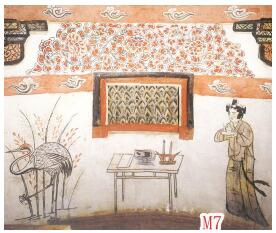
The tomb owner of M10 is Zhang Kuangzheng. The tomb is composed of front and back rooms, with a long rectangular room and a round back room. The west wall of the back room has a maid with a lantern, and the east wall has two maids. The left woman holds a mirror with both hands, and the right hand washes the dragon head and the right hand holds a towel. Obviously, she is waiting for the tomb owner to get up early. (Figure 10)
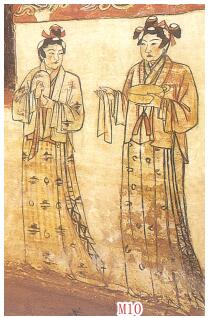
In the inner bedrooms of M6, M7 and M10, we found that there was no brazier for preparing tea. This kind of inner bedroom is relatively cold. What should we do? There is a brazier with a sunflower mouth on the east wall of M10 back room. Although there is no charcoal in the brazier, the intention for heating is very clear. (Figure 11)
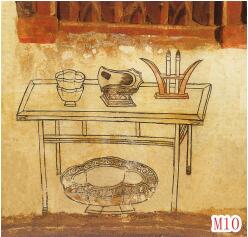
So, how to keep warm in M6 without brazier? We think that M6' s maid with a stove in her left hand is here to deliver the hand stove, which is placed on the table to keep warm. Put it on the table to find evidence. Look at the situation of Xuanhua Cemetery M1 and M4. The tomb owner of M1 is Zhang Shiqing, who was buried in 1116 AD. His family has a great cause. In the famine year, he offered 2,500 yuan of grain to the imperial court, and he was awarded the right class hall, and later the official went to Dr. Yinqing Chonglu. The tomb was the largest in Xuanhua cemetery. The tomb consists of front and back chambers, both of which are rectangular. The east wall of the back room is painted with a picture of preparing tea and waiting for sutras. A yellow sutra box, a black tea cup and a white soup bottle are placed on the red table in the middle. There are two sutra books at the front of the table, with a tea box and a five-legged stove between the books. This five-legged stove has a cover, which can ensure safety when reading classics. (Figure 12) The tomb owner of M4 is Han Shixun, who was buried in 1111 AD. The tomb is composed of front and back chambers, the front chamber is rectangular and the back chamber is hexagonal. The northeast wall of the back room is painted with a waiting diagram, and an arch-foot sutra table is placed on the square table. In front of the table, there is a lamp 2 and a five-foot stove 1. This five-foot stove is a reduced brazier for heating. This proves that heating appliances can be placed on the table for people to warm their hands when copying and reading scriptures. (Figure 13)

From this, we think that the two celadon stoves collected by Zhengzhou Shanhaiguan Museum and the incense burners and stoves appearing in many archaeological articles are all hand stoves used for heating at that time, which are different from braziers placed indoors on the ground. This kind of hand stove is not exactly the same as the five-legged small stove on the table or the sunflower brazier. It absorbs the characteristics of flat edge, inclined straight belly and round foot, and a short handle is added on the round foot, so that the shape of the stove is slightly slender, and it is more suitable for the surrounding objects.
Let's briefly introduce the age of these two hand stoves. Handmade stoves had a changing process in Song and Jin Dynasties. In Song Dynasty, the width of handmade stoves was relatively straight, the abdominal wall was straight, and the lower part was flared. The lower part of the abdomen was folded into a bottom, and there were generally convex edges on the circle feet. For example, in 1970, the Beijing Cultural Relics Management Office excavated the tomb of Mr. and Mrs. Wang Ze in 1053 AD, and unearthed an exquisite white porcelain hand stove, which was covered in a disc shape with no ribs on the handle and was 12.3 cm high. (Figure 14, left) In 2006, the Cultural Relics Bureau of Dengfeng City excavated a brick-carved tomb [9] in Gaocheng Town, Dengfeng City. A white porcelain hand stove was unearthed in the tomb, with a slightly downward-sloping width and a straight abdominal wall. The handle has two weeks of convex ribs and is 10.8 cm high. According to the brick carvings on the wall, this tomb dates from 1060 to 1090. (Figure 14) In 2001, Anyang Workstation, Institute of Archaeology, Chinese Academy of Social Sciences excavated a Song tomb [10] in the northern part of Liujiazhuang, Yinxu, and a white porcelain hand stove was unearthed in the tomb, with obvious characteristics. The straight mouth of the furnace is slightly ribbed, the width is inclined downward along the arc, the straight abdominal wall is folded into a flat bottom, and there is a raised edge on the short handle, and the horn is full, with a height of 12.6 cm. According to the latest copper coins unearthed in the tomb, this tomb is no later than 1094 AD. (Figure 14 right)
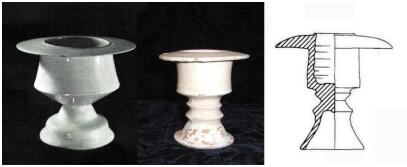
Through the comparison of the above three furnaces, we generally know that the wide edge of the handcraft in the late Northern Song Dynasty began to decline in an arc shape, which is different from the inclined straight wide edge earlier. The arc edge of Jin Dynasty became wider and deeper, which looked exaggerated. These two celadon hand stoves in our library are undoubtedly hand stoves before the late Song Dynasty. Considering the different production conditions in different places, it is not harmful to designate them as the early Jin Dynasty.
Index:
[1] Hebei Provincial Institute of Cultural Relics. Xuanhua Liao Tomb [M]. Cultural Relics Publishing House, Beijing, 2001.
[2] Zhengzhou Institute of Cultural Relics and Archaeology, Dengfeng Cultural Relics Bureau. Briefing on Excavation of the Song Dynasty mural tombs in Tangzhuang, Dengfeng, Henan [J]. Cultural Relics, 2012(9).
[3] Henan Institute of Cultural Relics and Archaeology. Tombs of Tang and Song Dynasties in Miaodigou, Sanmenxia [M]. Elephant Publishing House, September 2006.
[4] Henan Provincial Cultural Relics Bureau. Ceramics Unearthed from Yexian Collection [M]. Zhongzhou Ancient Books Publishing House, Zhengzhou, October 2017.
[5] Hebei Cultural Relics Protection Center, Baoding Cultural Relics Management Office, Mancheng Cultural Relics Management Office. Report on the Cleaning of the Tomb of Zhang Honglve and his wife in Yuan Dynasty [J]. Cultural Relics Spring and Autumn, 2013(5).
[6] Datong Museum. Excavation of Yan Deyuan's Tomb in Datong Jin Dynasty [J]. Cultural Relics, 1978(4).
[7] Nanle County Cultural Relics Management Office. Briefing on the tomb cleaning of Su Xu and his wife in Nanle, Henan Province in the Tang Dynasty [J]. Cultural Relics of the Central Plains, 2019(4).
Beijing Cultural Relics Administration. Several Liao Tombs Discovered in Beijing in recent years [J]. Cultural Relics, 1990(12).
[9] Song Songrui, Geng Jianbei, Fu Deli. Brief Report on Excavation of Brick Tomb in Shuangmiao Community of Dengfeng City, Henan Province [J]. Cultural Relics in the Spring and Autumn Period, 2007(6).
[10] Anyang Workstation, Institute of Archaeology, Chinese Academy of Social Sciences. Excavation Report of Tang and Song Tombs in the North of Liujiazhuang, Anyang, Henan [J]. Acta Archaeologica, 2015(1).

Follow official account